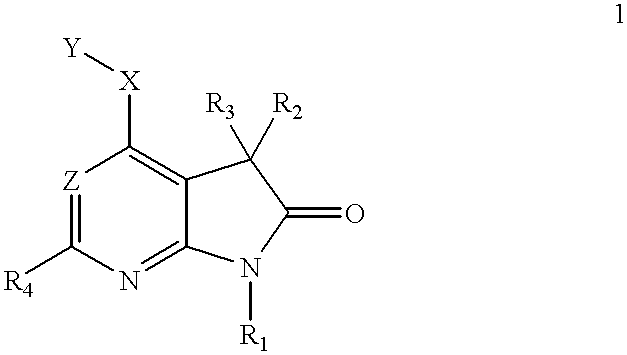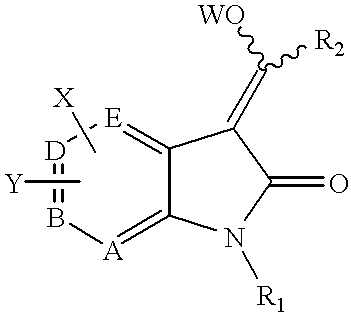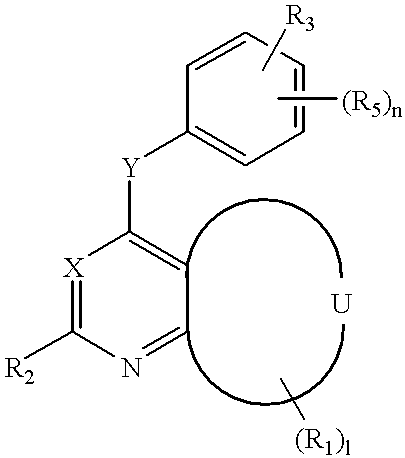4-substituted 7-aza-indolin-2-ones and their use as protein kinase inhibitors
a technology substituted 7azaindolin, which is applied in the field of protein kinase inhibitors, can solve the problems of many known protein kinase inhibitors that are unsuitable for clinical development, and achieve the effects of reducing symptoms, eradicating symptoms, and improving the effect of sensitivity
- Summary
- Abstract
- Description
- Claims
- Application Information
AI Technical Summary
Problems solved by technology
Method used
Image
Examples
example 1
5.1. Example 1
Synthesis of 4-Chloro-1.3-dihydro-pyrrolo[2,3-B]pyridin-2-one
1H-Pyrrolo[2,3-b]pyridine 7-oxide (1.86 g, 13.9 mmol, literature reference: J. Org. Chem. 45(20):4045-8 (1980)) was dissolved in 10 mL of phosphorus oxychloride. The reaction mixture was refluxed for 6 hours, cooled to room temperature and concentrated. The residue was extracted with ethyl acetate / water. The organic layer was washed with brine to pH 6, dried over anhydrous sodium sulfate, concentrated and dried in a vacuum oven overnight to give 0.88 g (42%) of 4-chloro-1H-pyrrolo[2,3-b]pyridine as a tan solid. .sup.1 H NMR (360 MHz, DMSO-d.sub.6) .delta. 11.99 (s, br, 1H, NH), 8.16 (d, J=5.15 Hz, 1H), 7.57 (t, br, J=3.38 Hz, 1H), 7.17 (d, J=5.15 Hz, 1H), 6.49 (dd, J=1.80, 3.38 Hz, 1H). MS m / e 153 [M.sup.+ ].
To a stirred solution of 4-chloro-1H-pyrrolo[2,3-b]pyridine (0.4 g, 2.6 mmol) in t-butanol (25 mL) was added pyridinium bromide perbromide (PBPB, 2.5 g, 7.8 mmol) portionwise. The reaction mixture was sti...
example 2
5.2. Example 2
Synthesis of 4-Chloro-5.7-dihydro-pyrrolo[2,3-D]pyrimidin-6-one
To a solution of 45.2 mmol of sodium ethoxide (made in situ from sodium and absolute ethanol) in 40 mL of absolute ethanol was added formamidine hydrochloride (1.74 g, 21.5 mmol) and 2-cyano-4,4-diethoxy-butyric acid ethyl ester (2.47 g, 11 mmol, literature reference: Davoll, J., J. Chem. Soc. 131-138 (1960)). The mixture was refluxed for 6 hours, cooled to room temperature and filtered. The solid was washed with hot acetonitrile. The filtrate was neutralized with acetic acid to pH 6.5 and then evaporated to half of the volume. Ethyl acetate (50 mL) was added to the resultant filtrate. The precipitate was filtered, washed with EtOAc to give 1.6 g (66%) of 6-amino-5-(2,2-diethoxy-ethyl)-3H-pyrimidin-4-one as a white solid which was used without further purification. .sup.1 H NMR (300 MHz, DMSO-d.sub.6) .delta. 11.46 (s, br, 1H, NH), 7.68 (s, 1H), 6.07 (s, br, 2H, NH.sub.2), 4.54 (t, J=6.0 Hz, 1H, CH(OCH.sub....
example 3
5.3. Example 3
Synthesis of 5-[4-(3-Chloro-4-fluoro-phenylamino)-2-oxo-1,2-didydro-pyrrolo[2,3-B]pyridin-3-ylidenemethyl]-4-methyl-1H-pyrrole-2-carboxylic Acid (2-Morpholin-4-yl-ethyl)-amide (Formula 3)
To ice-cold 3 mL (39.2 mmol) of N,N-dimethylformamide (DMF) was added phosphorus oxychloride (0.67 mL, 7.18 mmol) dropwise and the resultant mixture was stirred for 30 minutes. A solution of 1 g (6.53 mmol) of 4-methyl-1H-pyrrole-2-carboxylic acid ethyl ester in 3 mL of DMF was added to the reaction. After 1 hour, the reaction was warmed to room temperature for another 2.5 hours. The reaction mixture was diluted with water (100 mL) and basified to pH=11 with 1N sodium hydroxide solution. The precipitate was removed by filtration, rinsing with water and dried to afford 0.8 g (68%) of 5-formyl-4-methyl-1H-pyrrole-2-carboxylic acid ethyl ester as a white solid. .sup.1 H NMR (360 MHz, DMSO-d.sub.6) .delta. 12.6 (br s, 1H, NH), 9.78 (s, 1H, CHO), 6.68 (s, 1H), 4.26 (q, J=7.0 Hz, 2H, OCH.sub...
PUM
| Property | Measurement | Unit |
|---|---|---|
| concentration | aaaaa | aaaaa |
| concentration | aaaaa | aaaaa |
| concentration | aaaaa | aaaaa |
Abstract
Description
Claims
Application Information
 Login to View More
Login to View More - R&D
- Intellectual Property
- Life Sciences
- Materials
- Tech Scout
- Unparalleled Data Quality
- Higher Quality Content
- 60% Fewer Hallucinations
Browse by: Latest US Patents, China's latest patents, Technical Efficacy Thesaurus, Application Domain, Technology Topic, Popular Technical Reports.
© 2025 PatSnap. All rights reserved.Legal|Privacy policy|Modern Slavery Act Transparency Statement|Sitemap|About US| Contact US: help@patsnap.com



